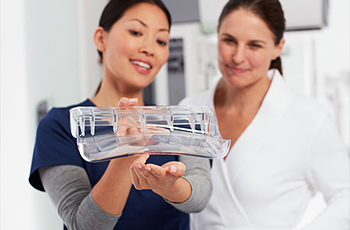
So you scheduled your mammogram, dutifully went in for your screening and later discovered you have dense breasts. What does that mean? Should you be worried or receive more tests?
Dr. Susan Ervine, Co-Medical Director, Holland Hospital Comprehensive Breast Services, helps clear up the confusion with answers to some common questions:
What is breast density
Breasts are made up of a mixture of fatty tissue, as well as fibrous and glandular tissue. Women with dense breasts have a higher amount of fibrous and glandular tissue and a lower amount of fatty tissue. Dense fibrous and glandular tissue appears white on a mammogram. Because breast masses are also white on a mammogram, dense tissue can make it more difficult to spot a mass on a mammogram.
Breast density is determined by the radiologist who reads your mammogram. There are four categories of breast density:
- Almost entirely fatty
- Scattered areas of fibro-glandular density
- Heterogeneously dense
- Extremely dense
Why do some women have dense breasts?
Almost half of all women age 40 and older who get mammograms are found to have dense breasts. While it isn’t fully understood why some women have dense breasts and others don’t, you’re more like-ly to have dense breast tissue if you are younger (breast tissue can become less dense with age), have a lower body-mass index (you have less body fat overall), and/or you take hormone therapy for menopau-sal symptoms.
Does dense breast tissue raise your cancer risk?
Yes, women with dense breasts have a higher risk of developing breast cancer compared to women with fatty breasts. Dense breast tissue also makes it more difficult to detect masses on a mammogram.
Should a woman with dense breasts continue to receive mammograms?
Yes, screening mammography is one of the best ways to detect cancer earlier when it’s easier to treat. All women should have a yearly mammogram beginning at age 40. Women with dense breasts should consider screening tomosynthesis (3D mammography) instead of traditional 2D mammography, as 3D mammograms allow the radiologist to more clearly see through dense breast tissue.
What can you do if you experience painful mammograms?
- Schedule your mammogram a week after your menstrual period.
- Tell your technician about previous history of painful mammograms.
- Cut down on caffeine. (Some patients find decreasing caffeine intake reduces breast pain.)
- Take an NSAID (non-steroidal anti-inflammatory drug, such as ibuprofen) 45 minutes to an hour be-fore your procedure.
- Ask your mammography facility if they offer additional comfort measures, such as the SmartCurve™ breast stabilization system. All three Holland Hospital mammography locations now feature SmartCurve. Without compromising image quality or accuracy, this system has been shown to improve comfort in 93 percent of patients who reported moderate to severe discomfort with standard com-pression.
No screenings beyond mammography have been mandated for women with dense breasts. That said, if you have dense breast tissue, talk to your doctor about your personal risk factors for breast cancer, and whether you should consider additional testing, such as 3D mammography, or a breast ultrasound or MRI.